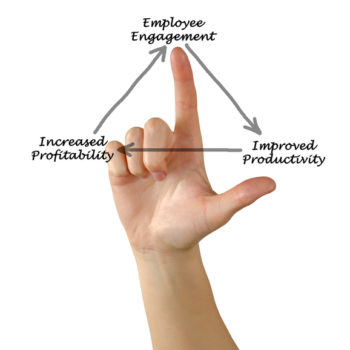3 Ways to Engage Your Team
With today’s busy-ness, it is important to have engaged team members and engaged teams working well together towards a common vision and creating new pathways forward. How can this be done? From my interviews with seven executives and managers from Canadian customer-centric organizations, this is what I learned.
Disengagement comes from three forms of obstacles – distractions, silo’s, and ambiguity. There are three ways to overcome these obstacles: 1) providing a focus and building belief around what is possible, 2) breaking down organizational silos through alignment, and 3) developing clarity. Here is a sampling of best practices to implement these three initiatives:
1. In order to focus on something, with so many available distractions, one must believe what they are doing is important and meaningful. “This creates actions and results” (Morana Bakula). It also “supports boundaries relating to priorities” (Lindsay Hammond, KPMG and Shannon Bayer, AVP Strategic Partnerships, Linkage, Inc.) and informs “organizational structure to provide what is important” (Liz Stretch, Chief People Officer at ATB). One way of starting on this is to determine your vision and mission and therefrom create behaviours that, when enacted by you and your team, bring you closer to the outcome you desire for the organization.
2. Alignment comes from recruiting people with people-centricity in their DNA (Liz Stretch, Chief People Officer, ATB Financial). Alignment also comes from providing clarity about why this is important, modeling from leadership and clear direction from leadership (Jeff Cates, President & CEO, Intuit Canada), consistency (Lindsay Hammond, KPMG), continued conversation, values alignment, training (Lindsey Smith, CIR Realty), latitude and accountability for all to do what is right in the moment for the customer, processes that allow your team and customers to interface easily with each other and with your systems (Morana Bakula, BBL, and Lindsey Smith, CIR), and acknowledgement and rewards for exemplifying team and customer engagement. Alignment takes dedication. It involves identifying shared values and individual values and holding each person accountable to closing the gap between their own and the organizational values.
3. To combat uncertainty, we need to support transition with ongoing communication, clear and common language, training and flexibility so that each team member may translate the vision into their areas of responsibility and “create positive impact rather than simply checking a box” (Adam Taylor, DDI). In addition, because uncertainty is inevitable, coaching for embracing uncertainty, normalizing it, and providing tools to deal with it is important. People need to feel safe to try new approaches, make mistakes, and learn in this ever-changing environment. For example, when we bring in change, we need to communicate the change in a way that is personal and relevant to each team and person, look for their ideas about how the change may be made in their areas, and let them try on those that are relevant as an experiment.
Engaging your team takes effort. The risk of not doing it is low productivity, poor results, and loss of team members and customers. As the saying goes, “If it were easy, everybody would do it!” It is the edge that organizations need to stay relevant in today’s exponentially, quickly changing world.
How are you and your organization adapting to today’s challenges.
If you are interested in discussing how Spark Success may support you with such initiatives, I invite you to schedule a conversation with me … just email me at jamie@sparksuccess.com.
With curiosity,
Jamie

